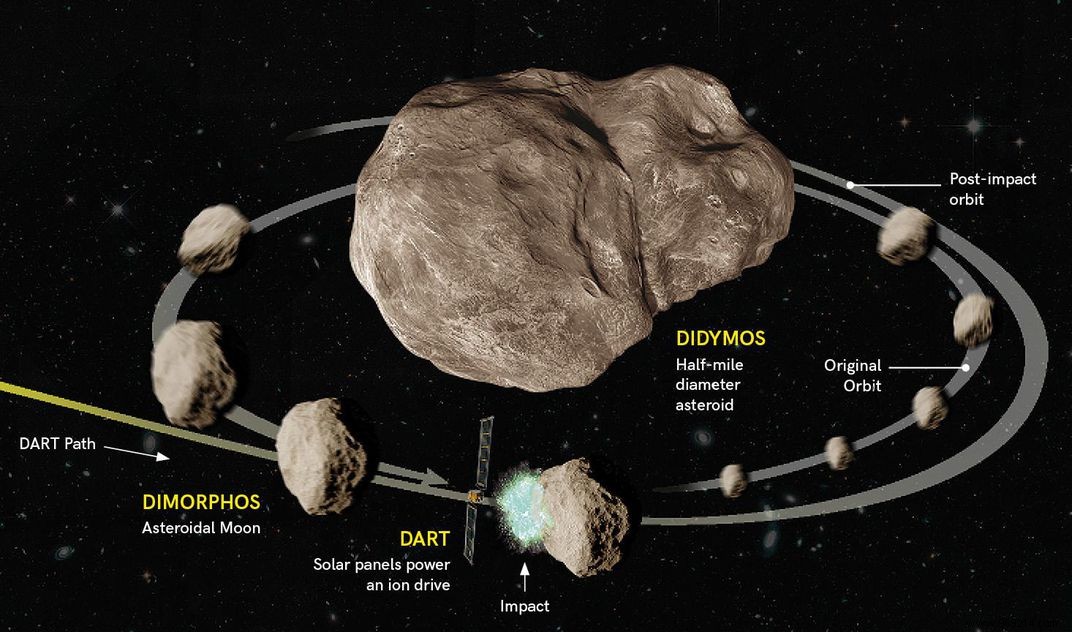In just over a year, after traveling more than seven million miles, a small vessel the size of a dishwasher will pounce on a small asteroid, itself orbiting a larger one as part of the DART mission. If all goes as planned, the trajectory of the small moon will have deviated enough to be detectable from Earth.
In March 1989 , (4581) Asclepius, an asteroid measuring about 700 meters across, approached Earth just 700,000 km away, attracting media attention at the time. And for good reason, in the event of impact, the object would have pierced a hole in the earth's crust with the force of 20,000 hydrogen bombs, digging a crater fifteen kilometers wide. Any life posted within 60 km would have been wiped out, while the dust would have affected several months of crop growth. In the event of an impact at sea, millions of people moving near the coast would have suffered major tsunamis.
Shortly after this "flirt" that no one saw coming, the US Congress tasked NASA with detecting and tracking any asteroids that might threaten our planet. Today, the agency has located more than 90% of all asteroids larger than a kilometer in diameter and always strives to locate all rocks over 140 meters in diameter. However, our planet is not immune to unpleasant surprises. Also, we must also consider ways to defend ourselves.
This brings us to the DART mission, which is scheduled to launch in November using a SpaceX Falcon 9 rocket. Its objective will be to hit an asteroid to deflect its trajectory.
Andy Cheng, one of the leaders of this mission, realized that we would need a binary asteroid system to analyze the effect of the impactor:the spacecraft strikes one of the two objects, then scientists observe the change in trajectory of the struck body around the other.
Cheng and his team quickly set their sights on an asteroid system called Didymos . It will indeed be closer to Earth next year than at any time in the next fifty years. The main asteroid was discovered in 1996, while its smaller moon, later named Dimorphos, or Didymoon, was spotted in 2003. The system orbits the sun at around thirty kilometers per second. Concretely, DART will only have one try to shift this speed by about one millimeter per second .
Seven days earlier, the mission team will have activated the ship's guidance system, built using APL guided missile technology, allowing this last to target Dimorphos himself. DART will not see its target clearly until approximately four minutes before impact, and must crash within fifteen meters of its aiming point.

The two objects are so far apart that they cannot be seen directly. Also, astronomers will detect any orbital changes by measuring the luminosity of Didymos . When its moon moves ahead relative to our position on Earth, Didymos will indeed darken ever so slightly. If the asteroid darkens a little earlier or a little later than it should according to the ephemeris, then the DART team will know that their mission has been a success.
In addition, DART will carry an Italian CubSat called LICIA which will separate from DART before impact to capture footage of its mothership's demise. In 2024, the European Space Agency (ESA) will also launch a probe named Hera to map the DART impact crater.
Of course, every space mission has its share of unknowns, but this one more than the others. Whether it's the exact nature of the pair of asteroids, the potential change in orbit of the smaller one, or the size and type of crater that DART will leave behind, all of this data still remains mysterious. Asteroids are indeed often unpredictable. However, this type of preventive missions serve precisely to answer all these questions.